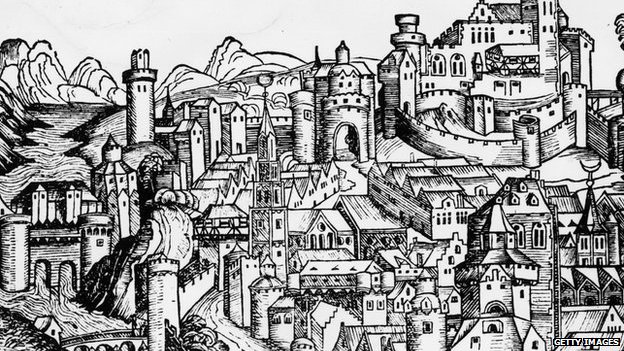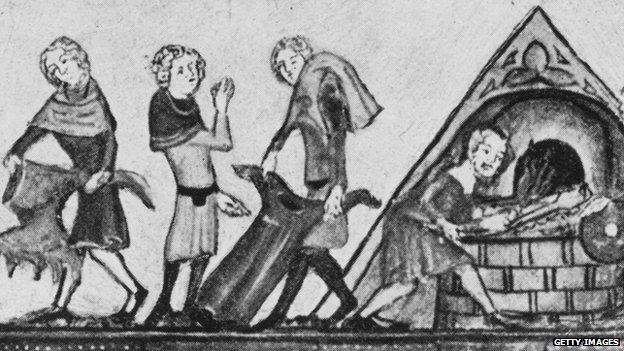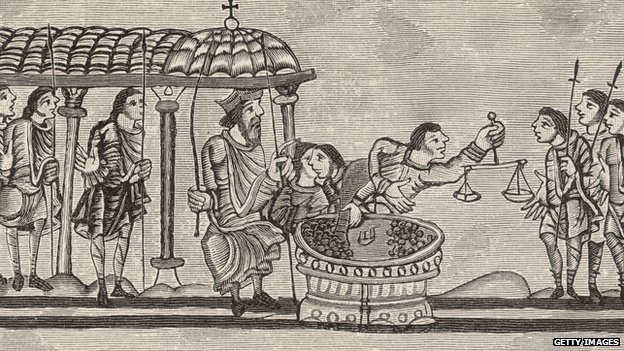17 February 2015
Last updated at 00:25
 About 65,000 people came to cities like London in the medieval period
About 65,000 people came to cities like London in the medieval period
In medieval England one person in every hundred was an immigrant, new research has shown.
About 65,000 people came to the country between 1330 and 1550.
The England’s Immigrants project by the universities of York and Sheffield details the names and occupations of those arriving from other parts of the British Isles and mainland Europe.
Project director Prof Mark Ormrod said the influx was largely a result of the Black Death creating a labour shortage.
He said: “We must remember that for a century or more after the Black Death the population of England was very low and there was plenty of work available.
“So people were coming from all across north-west Europe and also from further a field as well in search of that work.
“England was a magnet for immigrants in this period because the conditions and the wages were relatively good in comparison with back home.”
The Black Death
 Clothes infected by the Black Death were burnt in medieval Europe
Clothes infected by the Black Death were burnt in medieval Europe
- The first outbreak of plague swept across England in 1348-49
- It struck London in September 1348 and spread to East Anglia and along the coast the following year
- By spring 1349, it was ravaging Wales and the Midlands, and by late summer, it had made the leap across the Irish Sea
- It travelled north and reached Scotland by 1350
- The disease is thought to have killed between one third and one half of London’s population
The new database, accessible to the public, shows that in 1440, the names of 14,500 individuals were recorded, at a time when the population of England was approximately two million.
A number of weavers and goldsmiths from Flanders, now part of Belgium, are listed as well as servants brought back by aristocrats from English-occupied France at the end of the Hundred Years War.
Prof Ormrod said when they arrived many people were given a surname relating to their origin or trade.
“John Frenchman is the most frequent name in the whole of the database,” he said.
“[But] lots and lots of people who today have names like Baker, Brewer, Smith or Cooper could actually be descended from immigrants in the Middle Ages who were given a name when they came into the kingdom.”
Who, when, where?

- Three Flemish weavers from Diest in Belgium lived and worked in St Ives, Huntingdonshire, in the 1330s
- John Lammyns, a goldsmith from Antwerp, lived in Bristol in the 1430s and 1440s
- Sir John Montgomery of Faulkbourne, Essex, had five foreigners working in his household in the 1440s
- Walter, a minstrel from Germany, settled in London in the late 15th century with his entire family, including his mother, wife, three sons and three daughters
Nationalities listed in the database range from Scottish and Irish to Portuguese, Swedish, Greek and Icelandic.
“The England’s Immigrants project transforms our understanding of the way that English people and foreign nationals, of all levels of society, lived and worked together in the era of the Plantagenets and early Tudors”, added Prof Omrod.
Source Article from http://www.bbc.co.uk/news/uk-england-york-north-yorkshire-31462885
England's immigrant past revealed
http://www.bbc.co.uk/news/uk-england-york-north-yorkshire-31462885
http://news.search.yahoo.com/news/rss?p=immigrant
immigrant – Yahoo News Search Results
immigrant – Yahoo News Search Results
